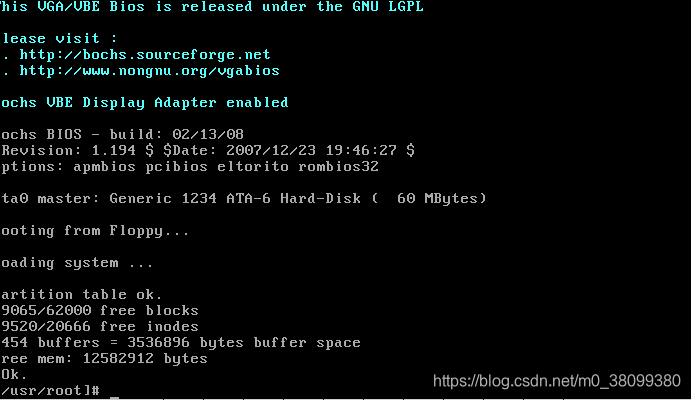实验内容
现在的Linux 0.11采用TSS和一条指令就能完成任务切换,虽然简单,但这指令的执行时间却很长,在实现任务切换时大概需要 200 多个时钟周期。而通过堆栈实现任务切换可能要更快,而且采用堆栈的切换还可以使用指令流水的并行优化技术,同时又使得CPU的设计变得简单。所以无论是 Linux还是 Windows,进程/线程的切换都没有使用 Intel 提供的这种TSS切换手段,而都是通过堆栈实现的。本次实践项目就是将Linux 0.11中采用的TSS切换部分去掉,取而代之的是基于堆栈的切换程序。具体的说,就是将Linux 0.11中的switch_to实现去掉,写成一段基于堆栈切换的代码。
编写switch_to函数
由于涉及到堆栈、ldt地址空间、pcb等切换内容,这些需要精细的操作,所以使用汇编代码编写这段程序。
.align 2
switch_to:
pushl %ebp
movl %esp,%ebp # get current sp
pushl %ecx # push the next LDT
pushl %ebx # push the next pcb pointer
pushl %eax # push eax
movl 8(%ebp),%ebx # get next pcb pointer
cmpl %ebx,current # compare it that if the next is the current process
je 1f
movl %ebx,%eax
xchgl %eax,current # change the PCB
movl tss,%ecx
addl $4096,%ebx
movl %ebx,4(%ecx) # rewrite the esp0 in the tss
movl %esp,KERNEL_STACK(%eax) # set the current kernel stack with sp
movl 8(%ebp),%ebx # get the next pcb pointer
movl KERNEL_STACK(%ebx), %esp # set the sp with the next kernel_stack
movl 12(%ebp),%ecx # get the parameter of the _LDT(next)
lldt %cx # modify the LDTR register
movl $0x17,%ecx
mov %cx,%fs # rewrite the register of fs
cmpl %eax,last_task_used_math # 和后面的clts配合来处理协处理器
jne 1f
clts
1:
popl %eax # pop eax
popl %ebx # pop ebx
popl %ecx # pop ecx
popl %ebp # pop ebp
ret # return
修改schedule函数
// linux-0.11/kernel/schedule.c
// old code
...
if ((*p)->state == TASK_RUNNING && (*p)->counter > c)
c = (*p)->counter, next = i;
....
switch_to(next);
// new code
...
if ((*p)->state == TASK_RUNNING && (*p)->counter > c)
c = (*p)->counter, next = i, pnext = *p;
....
switch_to(pnext, _LDT(next);
这里使用switch_to还需要在schedule.c的前面声明一下:
extern long switch_to(struct task_struct *p, unsigned long address);
修改PCB结构体
因为现在采用了堆栈方式切换,所以pcb结构体需要携带当前进程的栈顶指针krnstack。
...
// linux-0.11/include/linux/sched.h
long priority;
long krnstack; /* the pointer of the kernel stack */
long signal;
...
因为加在了pcb结构体中第4个位置,所以偏移量为12,那么它后续的变量地址也相应地偏移4个字节。这样的话结构体中的一些汇编硬编码的值也要跟着改变,下面是调整后的汇编硬编码:
// linux-0.11/kernel/system_call.s
state = 0 # these are offsets into the task-struct.
counter = 4
priority = 8
krnstack = 12
signal = 16
sigaction = 20 # MUST be 16 (=len of sigaction)
blocked = (33*16 + 4)
修改fork函数
在copy_process函数中加入下面这段代码,目的是复制当前内核栈的所有信息到下个进程的内核栈中,最后将内核栈指针设置到栈顶处:
// linux-0.11/kernel/fork.c
...
long *krnstack = 0;
krnstack = (long *)(PAGE_SIZE + (long)p);
*(--krnstack) = ss & 0xffff;
*(--krnstack) = esp;
*(--krnstack) = eflags;
*(--krnstack) = cs & 0xffff;
*(--krnstack) = eip;
*(--krnstack) = ds & 0xffff;
*(--krnstack) = es & 0xffff;
*(--krnstack) = fs & 0xffff;
*(--krnstack) = gs & 0xffff;
*(--krnstack) = esi;
*(--krnstack) = edi;
*(--krnstack) = edx;
*(--krnstack) = (long)first_return_from_kernel;
*(--krnstack) = ebp;
*(--krnstack) = ecx;
*(--krnstack) = ebx;
*(--krnstack) = 0; /* eax */
p->krnstack = (long)krnstack;
...
first_return_from_kernel这个变量其实是一段汇编代码的符号,作用是等到switch_to切换pcb后,也就是切换了内核栈以后,有一段退出出栈代码,等出栈eax、ebx、ecx、ebp后,就要ret了。这个ret就是出栈执行first_return_from_kernel这个汇编符号下的代码:
// linux-0.11/kernel/system_call.s
.align 2
first_return_from_kernel:
popl %edx
popl %edi
popl %esi
pop %gs
pop %fs
pop %es
pop %ds
iret
这段程序执行的时候就是刚好出执行完switch_to,进入内部的ret指令执行了。发现这里的代码都是出栈,这里出的栈就是当初copy_process压的栈。执行完这步后就准备进入用户态的出栈了,所以这个符号名字取作“首先从内核返回”
修改init_task
pcb结构体改变后,这个由此结构体的变量当然要更新啦:
// linux-0.11/include/sched.h
// old code
/* state etc */ { 0,15,15, \
// new code
/* state etc */ { 0,15,15, PAGE_SIZE+(long)&init_task, \
将栈指针初始化为栈底指针,因为这个时候还没有数据压栈,所以,栈顶指针与栈底指针相等。
注意schedule函数
// linux-0.11/kernel/schd.h
...
struct task_struct ** p;
// do not forget it that initing the pointer of pnext
struct task_struct * pnext = &(init_task.task);
...
别忘了初始化pnext时,一定要赋值初始化任务的指针哈,不然,系统是无法跑起来的。我在这里卡了快1天了。

实验结果

可以正常启动了,,,,,
总结
这个实验最难的内核栈的复制部分和switch_to部分,需要好好琢磨。